Charting a Course for Net Zero
Reaching Net Zero goals for maritime shipping by 2050 requires deploying advanced fuels and a suite of energy efficiency measures.
Maritime shipping enables between 80–90% of global trade and is the most efficient mode of transport when it comes to moving lots of goods long distances. However, increasing global trade demand is leading to higher energy use and growing sectoral emissions. In 2020, greenhouse gas (GHG) emissions from maritime shipping accounted for approximately 3% of all global emissions: If it were a country, it would be one of the top 10 polluters. With global shipping projected to grow at a rate of 2.4% per year through 2029, without appropriate measures to reduce carbon intensity – the amount of carbon emitted per unit of energy – sectoral growth could increase emissions by up to 130% compared to 2008 levels by 2050.
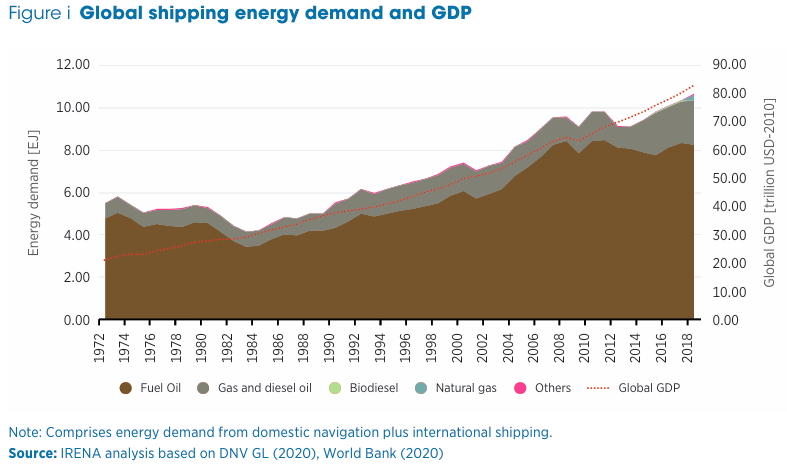
Setting the course for Net Zero
In 2018 the International Maritime Organization (IMO) adopted a strategy on the Reduction of GHG Emissions (updated in 2023), to reach net-zero emissions by 2050. In the short term, this means tapping into energy efficiency options both in ship design and operation and for the long term, replacing fossil fuels with renewable energy. To reach this goal, the IMO launched the GreenVoyage 2050 project and the Global Industry Alliance for Low Carbon Shipping (Low Carbon GIA) public/private partnership to work to collectively identify and develop innovative solutions for two workstreams: ship and port efficiency, and alternative low- and zero-carbon fuels.
The IMO GHG Emissions Reduction Strategy aims for:
- Net-zero GHG emissions by (or around) 2050
- Carbon intensity (CO2 emissions per transport work) to reduce by at least 40% by 2030 (compared to 2008)
- Uptake of zero or near-zero GHG emissions technologies to represent at least 5% (striving for 10%) of energy used in shipping by 2030
Put (absurdly) simply: all we need to do is ensure we have a state-of-the-art fleet powered by advanced renewable fuels (along with the necessary supporting infrastructure) and a sector that collaborates to optimise and prioritise energy efficiency from port to port (with all the cooperation and negotiation that entails).
Advancing advanced fuels
Let’s start with the long view: shifting from fossil fuels to renewable energy sources. This includes securing fuel options for the existing fleet – options that require little to no engine modification – while simultaneously developing the pipeline for new ships that run on low-to-zero-carbon fuels and building the necessary infrastructure to support the transition.
However, the future energy portfolio for shipping is still unclear, adding another layer to fleet renewal decisions. This uncertainty leaves shipowners in a difficult position: invest now, assuming the risk that the future policy environment will reward early adopters, or wait until the path is clear.
As it stands, the average age of the global shipping fleet is on the rise, a natural consequence of ageing, but the data show that the lifespan of older vessels is increasing and their removal from service is being delayed. Retrofitting these vessels is essential but requires shipowners to agree to extended periods of downtime.
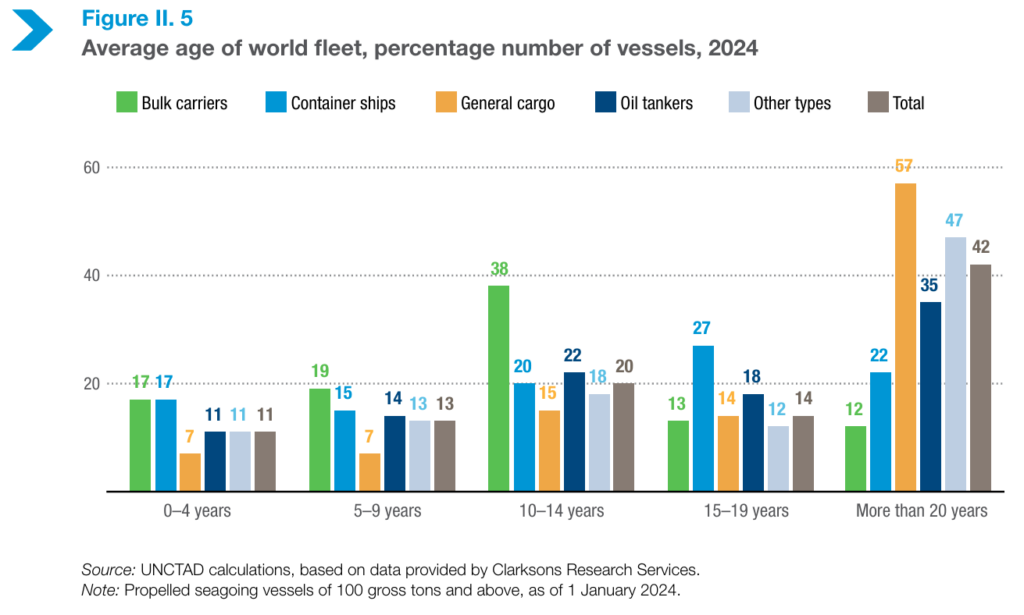
According to the UNCTAD review of the global shipping fleet in 2024, the demand for “greener” ships is increasing, but the pace needs to pick up: only 14% of the new global tonnage was alternative fuel-ready. However, further investment in greener vessels may be on the horizon: In 2025, the IMO struck a deal for a global CO2 price for emissions, to be in place from 2028. The final approval for the scheme will be decided in October 2025 and would provide a much-needed push for investment in a cleaner global fleet in both the short and long term.
Our first indicative target of 20–30% emissions reductions is five years away. Regardless of how many ships are commissioned, meeting this target requires that the sector taps into energy efficiency as a key strategy to reduce carbon intensity in the face of growing demand for shipping services.
How to ship more energy efficiently?
Energy efficiency is one of the key levers for emissions reduction (and cost reduction) in any context. Data show that the shipping sector has tremendous capacity to reduce energy consumption when inspired to do so: When fuel prices rise, energy efficiency measures rise, demonstrating that these options are ready to be employed when the right incentive is in place.
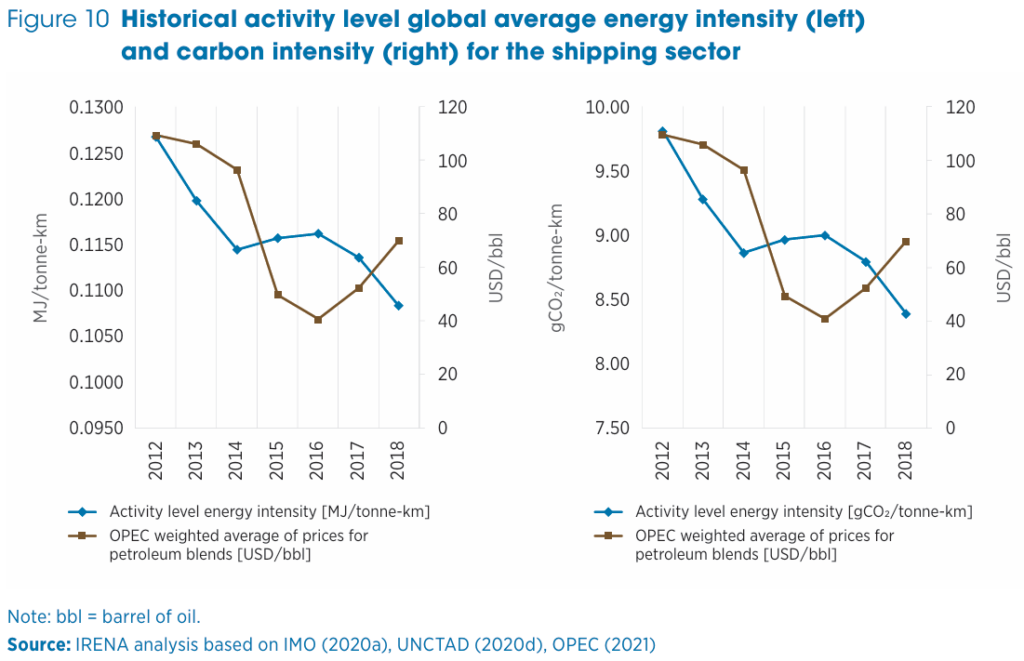
When looking at ship operations, several energy efficiency options exist. Some of these options require buy-in from shipowners, such as those related to vessel maintenance, while others depend on the commitment of the crew, including onboard energy management and fuel consumption reporting. Although implementing these measures involves costs and complexities, it is clear where the final decision-making authority lies. To drive action, the right incentives are necessary – such as requirements for shipowners to address hull and propeller maintenance, and the adoption of standard sector-wide contractual clauses to ensure consistent fuel consumption reporting.
For the third set of efficiency measures – voyage performance management – things get more complicated. These measures not only demand high-quality, real-time data, but also require a level of data-sharing and cooperation among competitors that is difficult to achieve in an increasingly challenging market.
Operational solutions to improve energy efficiency
Vessel maintenance measures
- Hull roughness and management
- Propeller roughness and management
Energy management systems
- Reducing onboard power demand
- Fuel quality and consumption reporting
Voyage performance optimisation
- Just-In-Time Arrival
- Ship speed optimisation
- Weather routing
- Autopilot improvements
Source: IRENA (2021), A pathway to decarbonise the shipping sector by 2050.
Among these options, Just-In-Time Arrival (JIT) involves the highest level of collaboration among stakeholders, requiring a veritable orchestra of actors to commit to a plan and stick to it in the face of external conditions – from bad weather to pirates. It’s a big ask, but the potential emissions reductions and data insights offer significant value across the sector and beyond.
Before we can understand the true size of the opportunity, we need to take a quick look at what the shipping sector looks like today.
“Hurry up and wait”
A container ship arrives at a port, just in time to have its goods unloaded, fuel up, and leave. On the way out, a bulk ship passes, arriving just in time to do the same.
For many on the outside of the sector, that seems like a reasonable statement. For those in the know, it sounds more like a pipe dream.
Today, the port call process (referring to the scheduled stop at a port for operational purposes, including cargo handling, refuelling, and compliance checks) follows a “hurry up and wait” model: In many cases, a ship may “hurry” to reach a port – optimising their journey for speed instead of fuel efficiency – then wait for days or even weeks until services are available. The data show that ships can spend up to 9% of their time waiting at an anchorage. During this time, while not using their main engines, auxiliary engines and boilers still require fuel, leading to pollution that puts the health of nearby communities at risk. In some cases, when a berth is not guaranteed, “waiting” involves slowly circling the area until a space frees up. It’s a far cry from the streamlined, optimised processes we often imagine underpinning the global economy.
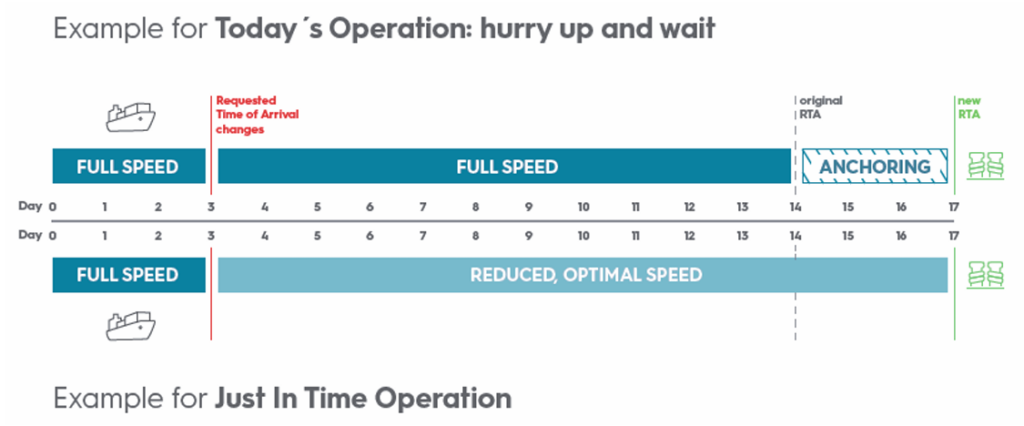
Arriving Just-In-Time
JIT Arrival allows ships to select the optimal ship speed to arrive at the port when the availability of berth, fairway, and nautical services is ensured. In this scenario, depending on port traffic, the ship may still have to wait if optimal speeds have them arrive before their slot, but journey emissions and waiting time are reduced significantly.
Studies show that fuel efficiency savings could range between savings of between 4% and 23%, depending on how early schedule changes are communicated between ships and ports. Additional benefits include less traffic and congestion, fewer collisions, reduced hull fouling, and reduced risk of being attacked by pirates – literally.
Looking beyond the shipping sector, the data needed to implement JIT Arrival could have cascading benefits for any industry that depends on stable supply chains – which, in today’s complex global economy, is virtually every sector.
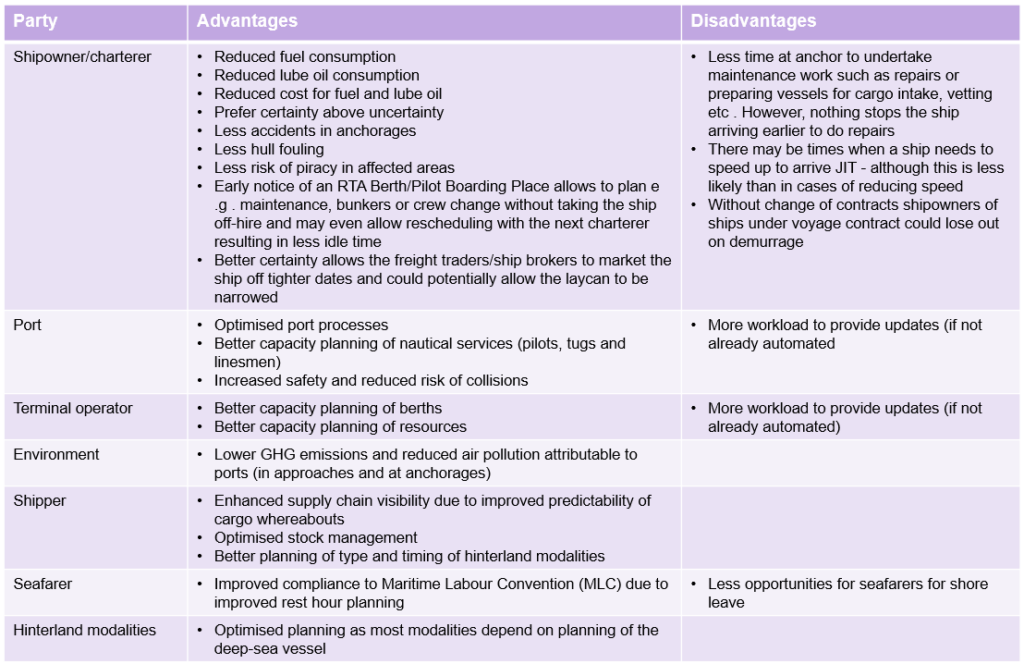
So, it’s a great idea. What’s the hold-up?
Implementing JIT Arrival requires high levels of collaboration and the timely exchange of data among many stakeholders , starting from the contractual phase through to port-to-port operations.
Checking the fine print: Contractual barriers to JIT
There are two main contact, or charter types to consider: Under a Time Charter, the charterer controls the vessel’s speed and covers all fuel costs, creating a built-in incentive to optimise for fuel efficiency. For voyage charters, it’s a different story.
To start, the standard voyage charter obliges the ship’s master to go to port with “utmost despatch” – as fast as you can – regardless of berth availability. More complex still is the relentless pace of trading and the impact of market prices. Goods on a ship may be traded between loading and discharge, with new agreements drafted constantly. As a result, even if JIT Arrival was planned in the original contract, any number of changes can occur during the voyage. Depending on exactly how the contracts are drafted, some ship masters may even prefer to “hurry up and wait”:
“A ship can be like a floating warehouse to some, where you can wait until the price is right to sell and offload goods.”
Dr. Julia Pahl, Associate Professor in the Section of Engineering Operations Management in the Department of Technology and Innovation at South Denmark University and Coordinator of the EU-funded MISSION project
With conflicting mandates and interests, appropriate incentives are essential. Julia Pahl, Associate Professor of Engineering Operations Management at South Denmark University, put it plainly: “It’s easy for us to assume that we are all committed to emissions reductions, but in real life, ship owners and charterers have obligations and salaries to pay and profit and loss sheets to balance.” As coordinator of the MISSION project, Pahl is working with stakeholders from across the shipping value chain and is well versed in the on-the-ground challenges facing JIT Arrival. The EU-funded project, launched in 2024, is developing software to support the integration of Just-In-Time port call functions to minimise maritime shipping waiting time in ports.
Operational barriers to JIT
JIT Arrival relies on the timely exchange of key timestamp data that allows each stakeholder to plan accordingly, from ships, shipping agents, port authorities, and terminal operators, to nautical (tugboats, pilots, and linesmen) and vessel services (bunker barges and waste collectors). This exchange faces several barriers, starting with the very definition of the relevant timestamps, to data ownership, the ease and willingness to share data, and data accuracy and frequency.
“We always think everything is digitalised and automated. But if we look at small(er) ports, what we may find is planning based on Excel sheets that may or may not be up-to-date”.
Dr. Julia Pahl, Associate Professor in the Section of Engineering Operations Management in the Department of Technology and Innovation at South Denmark University and Coordinator of the EU-funded MISSION project
Additional barriers to implementation arise from port processes, such as the capacity of nautical service providers and the presence of preclearance procedures, as well as the level of engagement and cooperation from key stakeholders, including port authorities, berth planners, ship operators, and nautical service providers.
Sailing towards 2050
As 2050 approaches, the pressure to improve efficiency and reduce emissions intensifies: Between the IMO’s increasingly stringent requirements for energy efficiency and the pending approval of a sector-wide carbon price in October 2025, the era of action and accountability is here.
In this context, JIT Arrival is not just a practical solution for logistical planning, but a strategic advantage for ports across the globe. By investing in port call optimisation, ports can offer ships the potential to improve their overall energy efficiency and comply with IMO targets. With the right incentives, technologies, and collaborations in place, the maritime sector is poised to improve efficiency, drive down emissions, and chart a course towards a net-zero future – just in time.